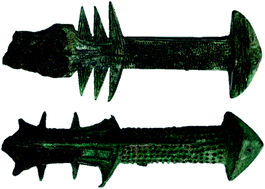An integrated approach between neutron diffraction and elemental imaging through neutron resonance transmission imaging: preliminary results on Chinese bimetallic sword fragments
Abstract
In this work, neutron diffraction (ND) and neutron resonance transmission imaging (NRTI) are applied for the material characterization of composite artefacts, two bimetallic sword fragments from ancient China, in order to highlight the presence and distribution of phases and elements in the objects. The investigation was carried out at the INES beamline, a time-of-flight powder diffractometer operating at the ISIS neutron and muon source in the UK. ND was applied to identify and quantify crystalline phases, while NRTI, by means of a position sensitive n-GEM based neutron detector, provided us with the distribution of different elements in the objects. NRTI demonstrates the possibility of enhancing several elements (e.g. Fe, Cu, Ag, Sn, Sb, As, Co, Cr, In, and Mn) in neutron transmission images, achieving a spatial resolution of about 1.6 mm. Elemental mapping was performed by selecting some of the most intense neutron resonances (up to several keV) in the absorption spectra.



 Please wait while we load your content...
Please wait while we load your content...